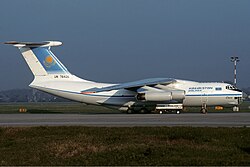Charkhi Dadri plane collision
| Charkhi Dadri plane collision | |
|---|---|
|
An identical Boeing 747 from Saudi Arabian Airlines |
|
| Accident summary | |
| Accident type | Airplane collision in the air |
| place |
Charkhi Dadri , Haryana India |
| date | November 12, 1996 |
| Fatalities | 349 |
| Injured | 0 |
| 1. Aircraft | |
| Aircraft type | Boeing 747-168B |
| operator | Saudi Arabian Airlines |
| Mark | HZ-AIH |
| Departure airport | Indira Gandhi International Airport , Delhi |
| Destination airport | Dhahran |
| Passengers | 289 |
| crew | 23 |
| Survivors | 0 |
| 2. Aircraft | |
| Aircraft type | Ilyushin Il-76 |
| operator | Kazakhstan Airlines |
| Mark | UN-76435 |
| Departure airport | Shymkent Airport |
| Destination airport | Indira Gandhi International Airport , Delhi |
| Passengers | 27 |
| crew | 10 |
| Survivors | 0 |
| Lists of aviation accidents | |
The collision of a Boeing 747 of Saudi Arabian Airlines on Saudi Arabian Airlines flight 763 and an Ilyushin Il-76 of Kazakhstan Airlines on Kazakhstan Airlines flight 1907 occurred on November 12, 1996 over the city of Charkhi Dadri in Haryana , India . With 349 victims, it was the most momentous aircraft collision in the air to date . The accident resulted in the fourth highest death toll in the history of aviation .
course
The Boeing 747 on Saudi Arabian Airlines Flight 763 took off on November 12, 1996 at 6:32 p.m. local time from Indira Gandhi International Airport in Delhi . There were 312 people on board the machine, mostly Indians working in Saudi Arabia . The destination of the flight was the Saudi city of Dhahran . At the same time, the Kazakhstan Airlines plane launched in Shymkent (flight 1907) was approaching Delhi airport. There were ten crew members and 27 passengers on board the Ilyushin Il-76 .
When they were 40 kilometers from the airport, the pilots of the Kazakh machine received instructions to descend to 15,000 feet. The Boeing oncoming them should rise to 14,000 feet at the same time. At 18:40 local time, the pilots of the Ilyushin reported that they had reached the specified altitude. In fact, with a continued descent, they were already at 14,500 feet. The responsible air traffic controller then warned the pilots of the oncoming aircraft. Since the descent was continued anyway, a collision occurred. As a result of the collision, part of the left wing and the left elevator of the Boeing 747 were torn off and it fell into an uncontrollable spiral dive in which the aircraft caught fire at a speed of 612 knots (approx. 1135 km / h) above the ground broke while the Ilyushin hit uncontrollably but largely intact. There were no survivors.
Aircraft accident investigation
The exact reason for the non-compliance with the altitude could never be determined. The investigation revealed that radio communications with the Kazakh machine were conducted via a radio operator who was seated away from the pilots. In addition, the cockpit instruments showed the flight altitude not in feet, but in meters. The height information transmitted by the radio operator therefore had to be converted. The Ilyushin had no collision warning device.
Since a large part of the airspace was reserved for the military, arriving and departing aircraft had to be guided through the same air corridor. Air traffic control only had an outdated radar system at its disposal, which indicated the position but not the altitude of the aircraft. It was therefore not possible for the air traffic controller to monitor compliance with the specified flight altitudes.
See also
Web links
- Photos of the two planes before the collision on Airliners.net
- Report on the accident
Individual evidence
- ^ A b c John F. Burns: One Jet in Crash Over India Ruled Off Course. New York Times , May 5, 1997, accessed December 23, 2011 .
- ↑ The pilots' last words . In: Berliner Zeitung , November 14, 1996; AFP message
- ^ Accident report B-747-100 HZ-AIH , Aviation Safety Network (English), accessed on November 13, 2015
- ^ Accident report IL-76 UN-76435 , Aviation Safety Network (English), accessed on November 13, 2015
- ^ Report on the accident
Coordinates: 28 ° 37 ′ 16.1 ″ N , 76 ° 16 ′ 6.1 ″ E

